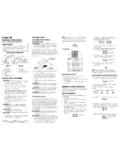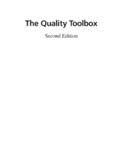Transcription of Advisory Circular - Federal Aviation Administration
1 Advisory Circular Subject: Use of Class 1 or Class 2 electronic Flight Bag (EFB) Date: 07/20/07 Initiated by: AFS-800 AC No: 91-78 1. PURPOSE. This Advisory Circular (AC) provides aircraft owners, operators, and pilots operating aircraft under Title 14 of the Code of Federal Regulations (14 CFR) part 91, with information for removal of paper aeronautical charts and other documentation from the cockpit through the use of either portable or installed cockpit displays ( electronic flight bags (EFB)). 2. APPLICABILITY. This AC is applicable to instrument flight rules (IFR) or visual flight rules (VFR), preflight, flight, and post flight operations conducted under part 91, unless prohibited by a specific section of 14 CFR chapter I. 3. TITLE 14 CFR REFERENCES AND RELATED READING MATERIALS (current editions). a. Part 91. (1) Section , Portable electronic devices (Subpart A-General). (2) Section , Preflight action (Subpart B-Flight Rules). (3) Section , Flying equipment and operating information (Subpart F-Large and Turbine-Powered Multiengine Airplanes and Fractional Ownership Program Aircraft).
2 (4) Section , Operating information required (Subpart K-Fractional Ownership Operations). b. ACs. (1) AC , Use of Portable electronic Devices Aboard Aircraft. (2) AC 120-76A, Guidelines for the Certification, Airworthiness, and Operational Approval of electronic Flight Bag Computing Devices. c. Miscellaneous. (1) FAA Notice N , electronic Flight Bag Job Aid. AC 91-PAP 7/20/07 (2) Annex 4 to the Convention on International Civil Aviation (ICAO), Aeronautical Charts, Chapter 20, electronic Aeronautical chart display . (3) RTCA/DO-200A, Standards for Processing Aeronautical Data. NOTE: EUROCAE ED-76A is equivalent to RTCA/DO-200A. 4. DEFINITIONS. The following definitions are specific to this AC and may differ with those definitions contained in other published references. a. electronic Flight Bag (EFB). An electronic display system intended primarily for cockpit or cabin use. EFB devices can display a variety of Aviation data ( , checklists, navigation charts, pilot s operating handbook (POH)) or perform basic calculations ( , performance data, fuel calculations).
3 The scope of the EFB system functionality may also include various other hosted databases and applications. Physical EFB displays may be portable (Class 1), attached to a mounting device (Class 2), or built into the aircraft (Class 3). b. electronic chart display (ECD). A display device that presents a comprehensive depiction of interactive information and/or precomposed information that is the functional equivalent of a paper aeronautical chart . An ECD may be a device installed in the instrument panel of an aircraft or a portable device. (ICAO, Annex 4, Chapter 20.) An ECD is not a multi-function display (MFD) that is permanently installed into an aircraft that is designed under a technical standard order (TSO). However an MFD may incorporate databases that depict checklists, navigation charts, POH, etc. c. Precomposed Information. Information that is previously composed into a static, composed state (non-interactive). The composed displays have consistent, defined, and verifiable content, and formats that are fixed in composition.
4 D. Interactive Information. Information presented on the EFB or ECD that, via software applications, can be selected and rendered in a number of dynamic ways. This includes variables in the information presented based on data-oriented software algorithms, concepts of decluttering, and on-the-fly composition as opposed to precomposed information. 5. BACKGROUND. Operators have long recognized the benefits of using portable electronic devices (PED), such as commercially available portable computers, to perform a variety of functions traditionally accomplished using paper references. EFB systems may be used in conjunction with, or to replace, some of the paper reference material that pilots typically carry in the cockpit. EFBs can electronically store and retrieve information required for flight operations, such as the POH and supplements, minimum equipment lists, weight and balance calculations, aeronautical charts and terminal procedures. EFB systems are being developed to support functions during all phases of flight operations.
5 Refer to AC 120-76A for complete details for installation of an EFB. Page 2 Par 4 7/20/07 AC 91-78 6. REMOVAL OF PAPER FROM THE COCKPIT FOR OPERATIONS UNDER PART 91. a. EFBs/ECDs can be used during all phases of flight operations in lieu of paper reference material when the information displayed meets the following criteria: (1) The components or systems onboard the aircraft which display precomposed or interactive information are the functional equivalent of the paper reference material. (2) The interactive or precomposed information being used for navigation or performance planning is current, up-to-date, and valid. NOTE: Supporting reference material such as legends, glossaries, abbreviations, and other information is available to the pilot but is not required in the cockpit during operation.
6 B. The in-flight use of an EFB/ECD in lieu of paper reference material is the decision of the aircraft operator and the pilot in command. Any Type A or Type B EFB application, as defined in AC 120-76A may be substituted for the paper equivalent. It requires no formal operational approval as long as the guidelines of this AC are followed. c. It is suggested that a secondary or back up source of aeronautical information necessary for the flight be available to the pilot in the aircraft. The secondary or backup information may be either traditional paper-based material or displayed electronically. 7. GENERAL CONSIDERATIONS. The in-flight use of EFB systems to depict images in lieu of paper reference material is the decision of the aircraft operator and the pilot-in-command. Any Type A or Type B EFB application, as defined in AC 120-76A, may be substituted for the paper equivalent. It is suggested that a secondary or backup source of aeronautical information or paper reference material necessary for the flight be available to the pilot in the aircraft.
7 The secondary or backup information may be either traditional paper-based material or displayed electronically by other means. Class 1 and Class 2 EFB can be used during all phases of flight operations in lieu of paper reference material when the information displayed meets the following criteria: a. The EFB system does not replace any system or equipment ( navigation, communication, or surveillance system) that is required by 14 CFR part 91. b. The EFB system on board the aircraft displays only precomposed or interactive information which are functionally equivalent to the paper reference material which the information is replacing or is substituted for. c. The interactive or precomposed information being used for navigation or performance planning is current, up-to-date, and valid, as verified by the pilot. d. The operator complies with requirements of 14 CFR part 91, to ensure that the use of the EFB does not interfere with equipment or systems required for flight.
8 Par 6 Page 3 AC 91-78 7/20/07 8. SPECIFIC CONSIDERATIONS. The operator ensures that for carriage and acceptable use of a: a. Class 1 EFB that it: (1) Is not dependent upon a dedicated aircraft power source or input from navigation equipment to provide display functionality, except it may connect to aircraft power through a certificated power source, cigar lighter; (2) Is not attached to an aircraft mounting device; and, (3) Is not connected with or receives data from any aircraft system. b. Class 2 EFB that it: (1) May receive power from the aircraft that is derived from an electrical bus source that is protected against short circuits with an appropriately rated circuit breaker or fuse; (2) May receive position reference from an onboard navigation system provided such input is designed and integrated in such a manner as to not adversely affect the output of the navigation source to which it is connected; and, (3) May be attached to a mounting device provided that such device is approved for installation into the aircraft, if intended for installation into a type certificated aircraft, then such mounting device must meet the requirements of 14 CFR part 21, 9.
9 RECOMMENDATIONS FOR IMPLEMENTATION. a. The operator should carry out an assessment of the human-machine interface and aspects governing Crew Resource Management when using the EFB. General considerations for the assessment includes workload, integration of the EFB into the cockpit, display and lighting issues, system shutdown, and system failures. More detailed assessment criteria can be found in the EFB Job Aid. Attention must be given to the physical EFB. Some items to consider are placement issues such as stowage during takeoff or landing, and the operation of an unsecured EFB. Use of the controls and input devices may be easy on the ground, but demanding in flight. (1) Training should include preflight checks of the system, the use of each operational function on the EFB, the conditions (including phases of flight) under which the EFB should not be used, and procedures for cross-checking data entry and computed information. b. Operators transitioning to a paperless cockpit should undergo an evaluation period during which the operator should carry paper backups of the material on the EFB.
10 The backup should be readily available to the crew. During this period the operator should validate that the EFB is as available and reliable as the paper-based system being replaced. Page 4 Par 8 7/20/07 AC 91-78 10. CONTACT. For additional information please contact the Commercial Operations Branch, AFS-820, at (202)267-8212. ORIGINAL SIGNED by John Duncan for James J. Ballough Director, Flight Standards Service Par 10 Page 5 (and 6)















